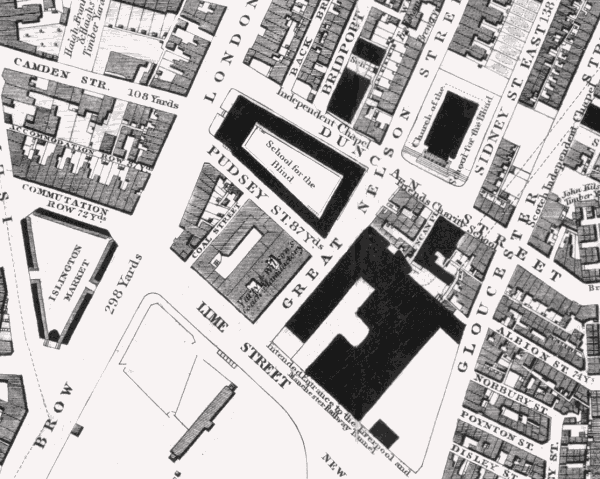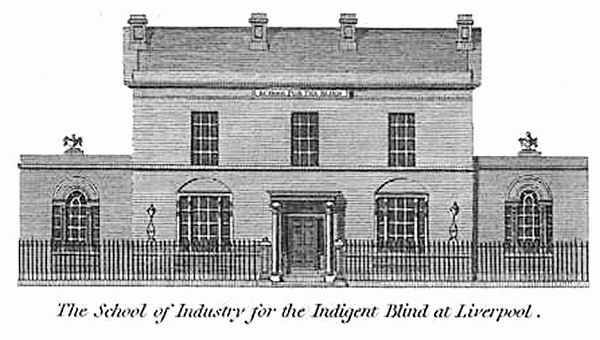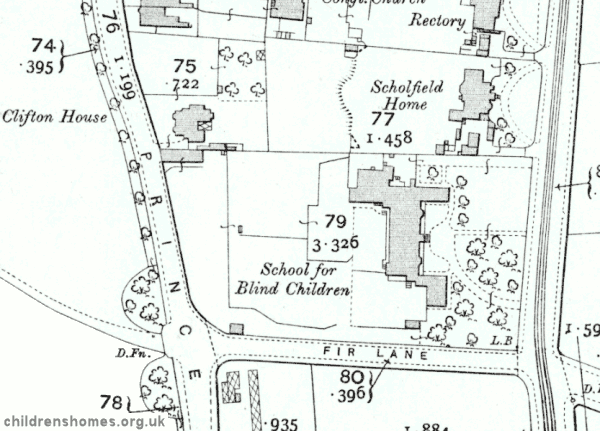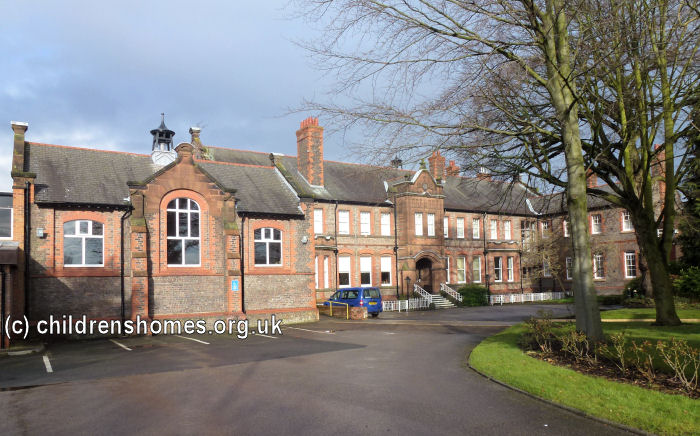School for the Indigent Blind, Liverpool, Lancashire
The Liverpool School for the Indigent Blind, also known as the Liverpool Blind Asylum, was founded in 1791 and was the earliest charitable institution in England catering specifically for blind children. The blind poet and reformer Edward Rushton usually credited with having originated the idea, though he was aided by a number of other supporters, notably his friend, John Christie, a blind musician, who became one of the School's first teachers, and the Rev. Henry Dannett, Vicar of St John's, Liverpool, who marshalled public support for the establishment.
The charity's first premises were at 6 Commutation Row, Liverpool. In 1800, the School moved into new premises on London Road, where residential accommodation for the pupils was provided for the first time. The map below, from 1836, shows the location of the Commutation Row and London Road sites.

School for the Blind, London Road site, Liverpool, c.1836.

School for the Blind, from the north-west, London Road, Liverpool.
In 1819, the Chapel for the School of the Blind was erected close by on Duncan Street, also shown on the above map.
The School provided to training for its pupils in a range of trades , which grew to include 'spinning, hamper and basket-making, the platting of sash line, the weaving of worsted rugs for hearths and carriages, and doors, of linen and of floor cloth and sacking, the making of sacks and list shoes, the manufacturing of twine, pack-thread, log-lines, clothes lines, and fish lines, of stair carpeting, and of foot bears, points and gaskets from old ropes, and the learning of music.'
Music could provided a useful route into employment — by 1825, fifty-nine of the School's pupils had proved sufficiently competent to be appointed as church organists. The pupils were also instructed in Dr Bell's 'Madras system' of teaching music to others, and in tuning and stringing musical instruments, which could also provide a livelihood.
In 1851, the School moved to new premises at 22 Hardman Street. The Duncan Street chapel was dismantled and re-erected alongside the new building.

School for the Blind, Hardman Street site, Liverpool, c.1908.

School for the Blind and its Chapel (left), from the north-west, Hardman Street, Liverpool.
In 1853, the clothing required for pupils admitted to the School was as follows:

Liverpool School for the Blind, clothing requirements, 1853.
By 1859, the male list had been supplemented by the addition of four pocket-handkerchiefs.
In 1856, potential applicants for admission were informed that 'Due to the numerous applications lately received for the admission of Infants, it is deemed necessary to state, that Females of less than Twelve Years, and Males of Fourteen Years of age, cannot be admitted into the School, except under very peculiar circumstances.'
The regulations regarding admission were stated in 1890 as:
In 1898, the Wavertree School for Blind Children was erected on Church Road, Wavertree, to receive children of school age. Around a third of the cost of the building was met by a £10,000 donation from Miss Mary Hornby, of Walton. The Hardman Street premises were then used as a technical and training centre for the adult blind. In 1928, the Chapel for the Blind at Hardman Street was closed. It was subsequently replaced by a new wing containing sales departments, workshops and domestic training areas.

School for the Blind, Wavertree site, Liverpool, c.1908.

Liverpool School for the Blind, from the south-east, Wavertree, 2013. © Peter Higginbotham
A major shake-up resulted from the 1944 Education Act. The Wavertree School became the charity's Junior School for the North West. Secondary School age children were transferred to the Henshaw's School in Manchester. The Hardman Street site became the Technical School in the North West for blind adolescent students, but closed in 1957.
In 1966, the charity was granted the title of the Royal School for the Blind, Liverpool.
In 1968, the Abbeyholme Preparatory School (formerly Scholfield House) adjacent to the Wavertree School closed and was purchased by the charity. Unfortunately, the building required demolition but became the site of the Blind School's adventure playground and mobility area. In 1973, another adjoining property, Clifton House was purchased and converted for use by the School.
In 1983, following extensive discussions, it was decided that the future role of the Wavertree School was to be the education and training of the visually handicapped child between the age of 3 and 18.
Records
Note: many repositories impose a closure period of up to 100 years for records identifying individuals. Before travelling a long distance, always check that the records you want to consult will be available.
Census
Bibliography
- Royden, M.W., Pioneers and Perseverance — A History of the Royal School for the Blind, Liverpool 1791-1991 (1991, Countywise)
- Higginbotham, Peter Children's Homes: A History of Institutional Care for Britain's Young (2017, Pen & Sword)
- Pritchard, D.G., Education and the Handicapped 1760-1960 (1963, Routledge & Kegan Paul)
- Wagg, Henry J A Chronological Survey of Work for the Blind (1932, Pitman)
Links
Except where indicated, this page () © Peter Higginbotham. Contents may not be reproduced without permission.


